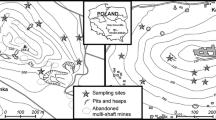Abstract
This study was conducted to assess the representativeness of laboratory sampling protocols for purposes of trace metal analysis in soil. Five laboratory protocols were compared, including conventional grab sampling, to assess the influence of sectorial splitting, sieving, and grinding on measured trace metal concentrations and their variability. It was concluded that grinding was the most important factor in controlling the variability of trace metal concentrations. Grinding increased the reproducibility of sample mass reduction by rotary sectorial splitting by up to two orders of magnitude. Combined with rotary sectorial splitting, grinding increased the reproducibility of trace metal concentrations by almost three orders of magnitude compared to grab sampling. Moreover, results showed that if grinding is used as part of a mass reduction protocol by sectorial splitting, the effect of sieving on reproducibility became insignificant. Gy’s sampling theory and practice was also used to analyze the aforementioned sampling protocols. While the theoretical relative variances calculated for each sampling protocol qualitatively agreed with the experimental variances, their quantitative agreement was very poor. It was assumed that the parameters used in the calculation of theoretical sampling variances may not correctly estimate the constitutional heterogeneity of soils or soil-like materials. Finally, the results have highlighted the pitfalls of grab sampling, namely, the fact that it does not exert control over incorrect sampling errors and that it is strongly affected by distribution heterogeneity.
Similar content being viewed by others
References
Boudreault JP, Dubé JS, Sona M, Hardy E (2012) Analysis of procedures for sampling contaminated soil using Gy’s sampling theory and practice. Sci Total Environ 425:199–207
CEAEQ (Centre d’expertise en analyse environnementale du Québec). 2010. Modes de conservation pour l’échantillonnage des sols. DR-09-02. Québec: Centre d’expertise en analyse environnementale du Québec
CEAEQ (Centre d’expertise en analyse environnementale du Québec) (2011) Détermination des métaux: méthode par spectrométrie de masse à source ionisante au plasma d’argon. MA. 200 – Mét 1.2, Rév. 1. Ministère du Développement durable, de l’Environnement et des Parcs du Québec, Québec
Dubé J-S, Sona M, Boudreault J-P, Hardy E (2014) Influence of particle size and grinding on measurement of trace metal concentration in urban anthropogenic soils. J Environ Eng 140(6). doi:10.1061/(ASCE)EE.1943-7870.0000825
Felt DR, Bednar AJ, Georgian T (2008) The effects of grinding methods on metals concentrations in soil. Talenta 77:380–387
Geelhoed B (2010) Chapter 3: modeling sampling processes at the particle level. In: Geelhoed B (ed) Approaches in material sampling. IOS, Amsterdam, pp 35–59
Geelhoed B (2011) Is Gy’s formula for the fundamental sampling error accurate? Experimental evidence. Min Eng 24:169–173
Gerlach RW, Nocerino JM (2003) Guidance for obtaining representative laboratory analytical subsamples from particulate laboratory samples. EPA/600/R-03/027. US Environmental Protection Agency, Washington
Gerlach RW, Dobb DE, Raab GA, Nocerino JN (2002) Gy sampling theory in environmental studies I: assessing soil splitting protocols. J Chemometr 16:871–878
Gerlach RW, Nocerino JM, Ramsey CA, Venner BC (2003) Gy sampling theory in environmental studies: 2. Subsampling error estimates. Anal Chim Acta 490:159–168
Gustavsson B, Luthbom K, Lagerkvist A (2006) Comparison of analytical error and sampling error for contaminated soil. J Hazard Mater 138(2):252–260
Gy PM (1992) Sampling of heterogeneous and dynamic material systems. Theories of heterogeneity, sampling and homogenizing, vol 10. Elsevier, Amsterdam, p 653
Gy PM (2004a) Sampling of discrete materials—a new introduction to the theory of sampling: I. Qualitative approach. Chemometr Intell Lab 74:7–24
Gy PM (2004b) Sampling of discrete materials—a new introduction to the theory of sampling: II. Quantitative approach—sampling of zero-dimensional objects. Chemometr Intell Lab 74:25–38
Gy PM (2004c) Sampling of discrete materials—a new introduction to the theory of sampling: III. Quantitative approach—sampling of one-dimensional objects. Chemometr Intell Lab 74:39–47
Pitard FR (1993) Pierre Gy’s sampling theory and sampling practice: heterogeneity, sampling correctness, and statistical process control, 2nd edn. CRC, Boca Raton
Ramsey MH (1998) Sampling as a source of measurement uncertainty: techniques for quantifications and comparison with analytical sources. J Anal Atom Spectrom 13:97–104
Compliance with Ethical Standards
ᅟ
Disclosure of potential conflicts of interests
The authors would like to acknowledge the financial support of the National Science and Engineering Research Council (NSERC) of Canada to this project through a Cooperative Research and Development grant to Professor Dubé (grant number CRDPJ 355151–07). This grant also included financial and in-kind support from Groupe Qualitas Inc.
Research involving human participants and/or animals
No human participants or animals were the subjects of this study.
Author information
Authors and Affiliations
Corresponding author
Additional information
Responsible editor: Céline Guéguen
Rights and permissions
About this article
Cite this article
Dubé, JS., Boudreault, JP., Bost, R. et al. Representativeness of laboratory sampling procedures for the analysis of trace metals in soil. Environ Sci Pollut Res 22, 11862–11876 (2015). https://doi.org/10.1007/s11356-015-4447-1
Received:
Accepted:
Published:
Issue Date:
DOI: https://doi.org/10.1007/s11356-015-4447-1




